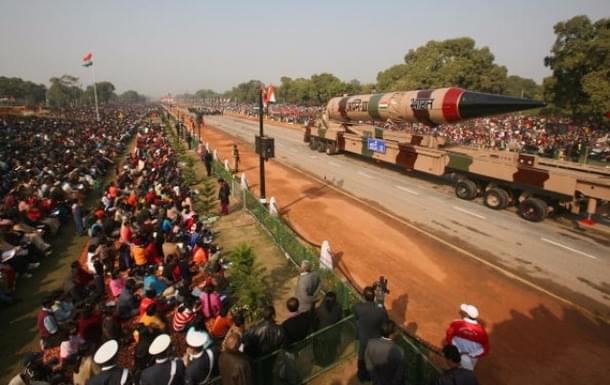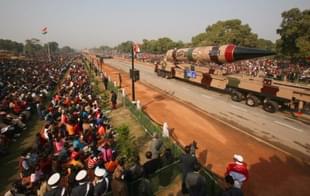Security
Why India Should Expand Its Nuclear Options
Rajesh Rajagopalan
Jan 13, 2017, 02:42 PM | Updated 02:42 PM IST
Save & read from anywhere!
Bookmark stories for easy access on any device or the Swarajya app.


Defence Minister Manohar Parrikar was roundly criticised when he ruminated out loud about generating greater uncertainty about India’s nuclear doctrine as a way of bolstering India’s nuclear deterrence. Parrikar was complaining about India’s No First Use (NFU) policy, which, in his view and the view of a number of analysts, ties India’s hand by assuring its adversaries that India will not be the first to use nuclear weapons.
There are strong reasons for retaining the NFU, but there are also strong reasons for expanding India’s nuclear options. Doing so could increase uncertainty about India’s nuclear responses and strengthen some elements of India’s nuclear deterrence. And there are ways of expanding India’s nuclear options without giving up NFU. The most pressing challenge that India faces is in finding a nuclear deterrence response to Pakistan’s threat of using tactical nuclear weapons (TNWs). This is one area where India can expand its options, to deter this threat and expand India’s conventional military options.
The NFU policy is definitely one rigid element in India’s nuclear policy. It is rigid because it limits India only to responding to a nuclear attack rather than taking the initiative. Still, there are good reasons for retaining the NFU because there are no plausible contingencies where India might need to initiate a nuclear attack. There might be some deterrence benefit to creating uncertainty by keeping open the option to initiate a nuclear attack rather than just respond to a nuclear attack. But any such benefit is far outweighed by the dangers of maintaining a first-use posture, including in terms of command and control, and safety and security.
But NFU is not the only rigid element in India’s nuclear doctrine. Equally rigid is India’s doctrinal promise that “Nuclear retaliation to a first strike will be massive and designed to inflict unacceptable damage.” This ties India down to a single response, a massive retaliation, irrespective of the type of the nuclear strike on India. In other words, even an attack by a small nuclear warhead on a forward Indian military column deep inside Pakistani territory would require India to launch a massive nuclear assault on multiple Pakistani cities. There are two problems with this: the first is the limitation imposed by the phrase ‘first strike’, and the second is the constraint imposed by a ‘massive retaliation’.
Using the phrase ‘first strike’ is rather odd in the Indian context, and it was probably the consequence of a lack of awareness of what ‘first strike’ means. In nuclear theology, ‘first strike’ means a nuclear attack that is designed to win the war by attacking first to eliminate as much of the enemy’s nuclear arsenal as possible, thus “crippling his means of retaliation”, as Lawrence Freedman put it. This would be akin to a nuclear Pearl Harbor, but presumably designed to be more successful than that effort.
But carrying out such a nuclear first strike is enormously difficult. First, this requires perfect intelligence about where all of the adversary’s nuclear weapons are so that they can all be destroyed in a single strike because any surviving weapons will be used in retaliation. Second, a first strike also needs a sufficiently large nuclear arsenal that would be able to devote multiple warheads for each target and, in addition, sufficient reserves for further attacks if needed. These requirements are not easy to meet for any nuclear force, especially having perfect intelligence. This makes no sense in India’s context because neither Pakistan nor China had or have anywhere near the kind of intelligence capacity or nuclear superiority that would allow them to pursue a ‘first strike’ option against India.
Thus, most likely, the framers of the doctrine simply used it to mean an initial nuclear attack – a ‘first’ attack. But, presumably, they also meant a strategic nuclear attack, since Pakistan’s ideas about tactical nuclear weapons came up much after the Indian doctrine was framed. In other words, it is very likely that Indian planners did not consider the possibility of Pakistan’s TNWs when they framed the original massive retaliation doctrine. What they considered ‘first strike’ was a strategic nuclear attack by either Pakistan or China, not the use of TNWs.
While it was reasonable in 2003 to assume that the most likely scenario for a nuclear attack on India would be a strategic attack, this is no longer the case. Pakistan’s move towards TNWs presents the possibility that India might have to deal with a much smaller-scale nuclear attack, carried out on Pakistani soil against Indian forces. Such an attack will require a different response from what the Indian nuclear doctrine proposes: ‘massive retaliation’. Massive retaliation also represents a rigidity in Indian nuclear doctrine, but one which, unlike the NFU, it is possible to alter, and for the better.
Though the phrase ‘massive retaliation’ itself is not used in the doctrine (rather, “retaliation . . . will be massive”), it is clear that it refers to a large-scale retaliation. In other words, irrespective of the kind of nuclear attack that India suffers, India’s nuclear doctrine suggests a heavy retaliation. In an important speech in 2013, Shyam Saran, the then head of the National Security Advisory Board, doubled down on this idea, asserting that India does not recognise any distinction between strategic and tactical nuclear weapons: “the label on a nuclear weapon used for attacking India, strategic or tactical, is irrelevant from the Indian perspective. A limited nuclear war is a contradiction in terms”, he argued. More recently, Shivshankar Menon, the National Security Advisor under Prime Minister Manmohan Singh, also made a similar argument in his recent book, stating that “there is little distinction in effect and practice between the use of tactical or strategic nuclear weapons in the India-Pakistan strategic context.”
Refusing to recognise the distinction between a strategic and tactical nuclear attack admittedly does create one deterrence problem for Pakistan. If a Pakistani decision-maker has to consider the possibility that even such a small-scale attack could result in a large-scale “massive” response, would they go through with a small-scale attack? In such a situation, would it not be better for Rawalpindi to launch a full-scale nuclear attack before India’s “massive” retaliation destroyed at least some of Pakistan’s nuclear capability? But if a full-scale nuclear attack were preferable to a tactical attack, would the loss of a small piece of territory justify a full-scale nuclear attack on India, especially considering that India will have to eventually return that territory (assuming this was territory outside Kashmir)?
Still, such a scenario creates an even greater dilemma for Indian decision-makers. Would a small, single Pakistani TNW attack, well inside Pakistani territory, against intruding Indian forces, justify a full-scale “massive” nuclear retaliation? Claiming that there is no distinction between an attack by a single, small-yield nuclear warhead, deep inside Pakistani territory on an invading Indian military column, and a nuclear attack on several major Indian cities by large-yield nuclear warheads delivered by long-range missiles is simply not tenable. Though the consequence of even a TNW attack would be terrible, it is not comparable to the effects of an attack on several large Indian cities. And the fact that such a Pakistani TNW strike would likely happen inside Pakistani territory would be important too: Would Indian decision-makers launch a “massive” nuclear strike on multiple Pakistani cities if Indian territory itself has not suffered a direct nuclear attack?
One way out of this quandary would be for India to expand its choices in responding to such an attack, rather than stick to the one-size-fits-all “massive retaliation”. India could consider, as some have suggested, a ‘proportionate response’ or ‘flexible response’ strategy. The main problem with this strategy is the general assumption that tactical nuclear options require tactical nuclear forces that have to deployed in ready state, with pre-delegated authority, in forward areas. TNWs are usually mounted on short-range missiles, and the dangers associated with such weapons are well-recognised. When the Cold War ended, both the United States and the Soviet Union unilaterally withdrew most of their TNWs because they recognised these dangers.
But it is possible to expand India’s options to respond to Pakistan’s TNWs without also deploying TNWs. India should consider deploying much smaller-sized warheads, but delivered by bombers rather than missiles, to retaliate against any Pakistani use of TNWs. Such a move would allow India to have a TNW capability, but without having to deploy the associated short-range weapons that make TNWs generally unpalatable. This would also require India to slightly modify its nuclear doctrine to assert that India will determine the choice of response, without specifying that this will necessarily be a massive retaliation, thus removing the rigidity imposed by the current “massive retaliation” doctrine.
There are several advantages to such an expansion. First, it offers Indian decision-makers greater choice than just “massive retaliation”, which is not particularly credible in responding to a possible use of Pakistan’s TNWs. Smaller nuclear warheads offer India the option of responding proportionately. While there is a possibility (but, it is important to note, no certainty) that such tit-for-tat attacks might escalate to the strategic level, responsibility for such an escalation should also be an important consideration. It is difficult to imagine that India wants to claim responsibility for such an escalation, which is implicit in the argument that the strategic-tactical distinction is irrelevant. Having additional options beyond “massive retaliation” is necessary to give Indian decision-makers a non-escalatory nuclear choice.
Second, having smaller, air-delivered nuclear warheads overcomes a key problem with TNWs: the command-and-control problems that come with forward-deployed short-range missiles. It would require no change in India’s command-and-control arrangements, and allow for as strict central control and safety protocols as India’s strategic weapons, including de-mated weapons and political control over the decision to use nuclear weapons. Such deployment removes any additional worries about the possible theft of or accident related to forward-deployed weapons, or the possibility of the inadvertent use or the ‘use-them-or-lose-them’ dilemma, all staple problems with TNWs.
Third, using centrally-controlled TNWs diminish the chance of arms race escalation. Deploying short-range tactical nuclear missiles to match what Pakistan is threatening to deploy could lead to a spiraling arms race in TNWs in the region. Deploying a few additional, smaller-sized warheads to airbases should not lead to such escalation. It would, at best, add a couple more small-sized warheads to India’s nuclear force.
Fourth, this requires India to develop no new capabilities, other than designing a smaller warhead. India did test three sub-kiloton devices in 1998, which makes this task much easier. India has aircraft that are nuclear-capable, including the Jaguar and the Mirage-2000, that can be adapted to this role.
Finally, developing additional nuclear options will allow India to develop more conventional war options to retaliate against Pakistan’s use of terrorism. Though Pakistan’s nuclear weapons are not the sole reason why India does not retaliate to Pakistan-sponsored terrorist attacks – India’s conventional capacity is itself an issue, as is India’s generally risk-averse policy preferences – having more conventional war options could also complicate Pakistan’s own choice in supporting terrorism as policy against India. Part of the reason why Pakistan has emphasised TNWs in the last few years is Rawalpindi’s fears that India was developing such conventional war options through its ‘Cold Start’ doctrine.
India needs more nuclear weapons use options than that of either not responding to a Pakistani TNW strike or responding with a “massive” strike. The fear that developing such capabilities might be risky or lead to nuclear war-fighting is unwarranted because there are ways to develop tactical nuclear options without developing tactical nuclear weapons. India needs to move from its rigid “massive retaliation” doctrine to a much more flexible doctrine that allows for greater choices.
This piece was first published on Observer Research Foundation and has been republished here with permission.




